31-Aug-2011
Comments Off on >Back to Fitness: The 3 R’s
>Back to Fitness: The 3 R’s
Category : Exercise
>
Did your fitness routine go freestyle this summer? The trouble with summer is that people tend to be inconsistent about exercising. This happens for a multitude of reasons: a) the kids are home; b) week-long vacations and travel; c) relying on outdoor activities like gardening and walking for exercise.
Now that September is here it is time to get back to fitness! How to start? ”Back to School” and “Back to Fitness” have a lot of similarities. Here are the “Three R’s”:
Regular Routine
Schedule your exercise. Consistency is the key to success. “I am going to get in shape this fall” is far too vague. Instead, say “I am going to exercise for 30 minutes three days a week for the next 4 weeks.” You should consider being even more specific and schedule the days you will exercise on your calendar. Notice how this statement is measureable in couple of ways (minutes of exercise & days per week) it also has a time frame of 4 weeks so when you have successfully exercised through out the month of September you can reward yourself. Then you can set a new goal (maybe 4 days/week) for the month of October!
‘Rite it down
There are two things to write down:
1) Write your goals. Post them somewhere you can see them regularly and act upon them. It is important to review your goals daily…for one minute. Spencer Johnson, M.D., in his book The One Minute Mother gives us this motivational quote: “I take a minute, I look at my goals, I look at my behavior, I see if my behavior matches my goals”.
2) Record your workouts. It may seem silly, but most grown-ups are just as motivated as grade-schoolers by something as simple as a chart on the wall with gold stars. Try this at home: Place a calendar which is dedicated to keeping track of your workouts in a prominent location such as your refrigerator. Everyday you workout give yourself a star on the calendar. You may also want to record your time, distance and/or the activities you completed.
‘Rithmetic
A lot of us are motivated by the numbers.
Most people feel they MUST weigh themselves, however don’t measure success by that number alone. Here are some other numbers to consider:
Body composition (the ratio of fat to lean body tissue) is much more important. This can be measured with a skin fold calipers by a fitness professional.
Keep track of inches lost with a tape measure. Record your girth measurements around your waist, hips, and upper leg. Measure them again in one month. The tricky part is measuring the same spot the next time, so take good notes. For example, when you measure your waist pay attention: did you measure across your belly button or two inches above your belly button?
How many push-ups you can do without stopping, how many chair squats you can complete in 30 seconds and how long it takes you to walk/run a specific distance such as one mile (works best on a track)? Re-test every eight to twelve weeks and you will be impressed with yourself!
How many minutes and/or miles you complete weekly or monthly?
Turn over a new leaf this Fall…follow the “Three R’s” and get fit this fall. Remember, consistency is the key to success! If you have a health & fitness question or need help with your fall fitness routine contact me: karin@xofitness.com
Karin Jennings is a certified personal trainer and co-owner of XO Fitness, LLC in De Pere.
Did your fitness routine go freestyle this summer? The trouble with summer is that people tend to be inconsistent about exercising. This happens for a multitude of reasons: a) the kids are home; b) week-long vacations and travel; c) relying on outdoor activities like gardening and walking for exercise.
Now that September is here it is time to get back to fitness! How to start? ”Back to School” and “Back to Fitness” have a lot of similarities. Here are the “Three R’s”:
Regular Routine
Schedule your exercise. Consistency is the key to success. “I am going to get in shape this fall” is far too vague. Instead, say “I am going to exercise for 30 minutes three days a week for the next 4 weeks.” You should consider being even more specific and schedule the days you will exercise on your calendar. Notice how this statement is measureable in couple of ways (minutes of exercise & days per week) it also has a time frame of 4 weeks so when you have successfully exercised through out the month of September you can reward yourself. Then you can set a new goal (maybe 4 days/week) for the month of October!
‘Rite it down
There are two things to write down:
1) Write your goals. Post them somewhere you can see them regularly and act upon them. It is important to review your goals daily…for one minute. Spencer Johnson, M.D., in his book The One Minute Mother gives us this motivational quote: “I take a minute, I look at my goals, I look at my behavior, I see if my behavior matches my goals”.
2) Record your workouts. It may seem silly, but most grown-ups are just as motivated as grade-schoolers by something as simple as a chart on the wall with gold stars. Try this at home: Place a calendar which is dedicated to keeping track of your workouts in a prominent location such as your refrigerator. Everyday you workout give yourself a star on the calendar. You may also want to record your time, distance and/or the activities you completed.
‘Rithmetic
A lot of us are motivated by the numbers.
Most people feel they MUST weigh themselves, however don’t measure success by that number alone. Here are some other numbers to consider:
Body composition (the ratio of fat to lean body tissue) is much more important. This can be measured with a skin fold calipers by a fitness professional.
Keep track of inches lost with a tape measure. Record your girth measurements around your waist, hips, and upper leg. Measure them again in one month. The tricky part is measuring the same spot the next time, so take good notes. For example, when you measure your waist pay attention: did you measure across your belly button or two inches above your belly button?
How many push-ups you can do without stopping, how many chair squats you can complete in 30 seconds and how long it takes you to walk/run a specific distance such as one mile (works best on a track)? Re-test every eight to twelve weeks and you will be impressed with yourself!
How many minutes and/or miles you complete weekly or monthly?
Turn over a new leaf this Fall…follow the “Three R’s” and get fit this fall. Remember, consistency is the key to success! If you have a health & fitness question or need help with your fall fitness routine contact me: karin@xofitness.com
Karin Jennings is a certified personal trainer and co-owner of XO Fitness, LLC in De Pere.
16-Aug-2011
Comments Off on >XO Fitness welcomes Ann Oviatt to their personal training team!
>Ann Oviatt, CPT PERSONAL TRAINER

Philosophy:
Exercise is more than just burning calories, exercise can improve your quality of life, so keep moving!
My mission is to educate others in the many ways exercise can improve their health and quality of life. For example: Exercise can lower blood sugar and blood pressure, improve bone density and even help improve some of the issues that come with cancer treatments – the nausea and fatigue, as well as the anxiety and depression that are so common.
My decision to become a personal trainer was officially made when I found significant evidence of how exercise could have improved my grandmother’s quality of life – and nobody had ever suggested she do anything but “take it easy”.
I spent several years as my grandmother’s caregiver while she was struggling with diabetes, complications from osteoporosis, and finally pancreatic cancer. While researching her general conditions, I found vague references about the benefits of “keeping active”, but not enough information in a useable form to be much use to me and my grandmother.
Later, as I did more research to improve my own health and try to avoid the health issues that run in my family I kept coming back to fitness – strength, cardio and balance training.
Philosophy:
Exercise is more than just burning calories, exercise can improve your quality of life, so keep moving!
My mission is to educate others in the many ways exercise can improve their health and quality of life. For example: Exercise can lower blood sugar and blood pressure, improve bone density and even help improve some of the issues that come with cancer treatments – the nausea and fatigue, as well as the anxiety and depression that are so common.
My decision to become a personal trainer was officially made when I found significant evidence of how exercise could have improved my grandmother’s quality of life – and nobody had ever suggested she do anything but “take it easy”.
I spent several years as my grandmother’s caregiver while she was struggling with diabetes, complications from osteoporosis, and finally pancreatic cancer. While researching her general conditions, I found vague references about the benefits of “keeping active”, but not enough information in a useable form to be much use to me and my grandmother.
Later, as I did more research to improve my own health and try to avoid the health issues that run in my family I kept coming back to fitness – strength, cardio and balance training.
EXPERIENCE & CREDENTIALS
- NASM certified personal trainer
- First aid and CPR certified
- Studied dance for 18 years including ballet, tap, jazz and modern (Later I discovered belly dance and it was love at first shimmy!)
- Currently studying to complete a B.S. Human Biology with an emphasis in nutritional science at UWGB
- Spending time with my family
- Gardening
- Belly dance
- Making jewelry
AVAILABILITY
Ann will be available for trainings starting September 6th.
Her hours will be typically be 2:30-7 PM, 2011
23-Mar-2010
Comments Off on >Exercise #1: Squats anytime & anywhere
>Exercise #1: Squats anytime & anywhere
Category : Exercise
>
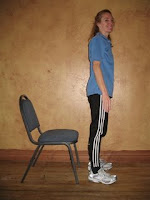
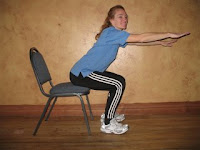 If you need more of a challenge try Speed Squats: Do as many squats as you can in 30 seconds; rest 30 seconds and repeat as many times as you dare. You can also try the Wave: When you stand up, raise your arms overhead and lift up onto your toes…imagine “doing the wave” at Lambeau Field!!! Be sure to do this during the commercials next time you are sitting on the couch watching the Packers…your friends will love you (just kidding!!)
If you need more of a challenge try Speed Squats: Do as many squats as you can in 30 seconds; rest 30 seconds and repeat as many times as you dare. You can also try the Wave: When you stand up, raise your arms overhead and lift up onto your toes…imagine “doing the wave” at Lambeau Field!!! Be sure to do this during the commercials next time you are sitting on the couch watching the Packers…your friends will love you (just kidding!!)

Stand in front of a chair with your feet about hip width apart. Slowly lower yourself down as if you were going to sit in the chair and extend your arms out in front of you for balance. The object is to keep your weight on your feet and not transfer it to your seat.
Stand up again as soon as you feel the chair. Start with 10 in a row and work up to 15. Take a break and repeat. Be sure to keep your knees over your ankles with your weight on your heels and keep your knees from caving in toward one another.
23-Mar-2010
Comments Off on >Move of the Month
>Move of the Month
Category : Exercise
>Squats anytime & anywhere.
They are great for your butt & thighs…
The only equipment you need is a chair!
What to do…
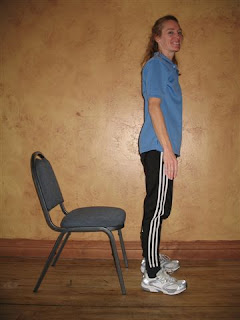 2) Slowly lower yourself down as if you were going to sit in the chair & lift your arms out in front of you to help you keep your balance.
2) Slowly lower yourself down as if you were going to sit in the chair & lift your arms out in front of you to help you keep your balance.

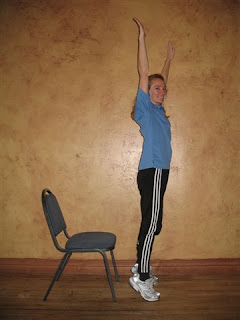 Try Speed Squats
Do as many chair squats as you can in 30 seconds. These are one of my favorites…they will really get your heart pounding!
Sit and rest for 30 seconds, repeat
Try Speed Squats
Do as many chair squats as you can in 30 seconds. These are one of my favorites…they will really get your heart pounding!
Sit and rest for 30 seconds, repeat
1) Begin in a standing position, feet about hip distance apart.
3) As soon as you feel the chair with your butt stand up again. The object is to keep your weight on your feet and not transfer it to your seat. The chair is only there for security…in case your arms don’t work as ballast and you have to sit down!
How many?
Start with 10 in a row (repetitions) and work up to 15.
Take a break and do 10-15 more.
Alignment
Try to keep your knees over your ankles with your weight on your heels. They may move forward slightly, but never allow them to go past your toes.
Also, your knees should not cave in toward each other.
Need more challenge?
Try the Wave
When you stand up, raise your arms overhead and lift up onto your toes…imagine “doing the wave” at Lambeau Field!!
Be sure to do this during the commercials next time you are sitting on the couch watching the Packers…your friends will love you (just kidding!!)
28-Jul-2009
Comments Off on >Improve your Metabolism
>Improve your Metabolism
Category : Exercise
>By: Ryan Jennings
I recently attended a fitness convention in Chicago to update my personal training skills and earn CEC’s (continuing education credits). One of the most cutting edge workshops I attended was entitled: “Metabolic Training: The New Cardio Program”. The course promised to help people identify one of their own metabolic markers and systematically use it to improve their metabolism. The training was presented by Fabio Comana, who teaches exercise science and nutrition at the University of California-San Diego and is also the exercise physiologist for the American Council on Exercise (ACE).
A Quick Review of Energy Sources
To understand metabolism you need to recognize that your body uses different sources of energy for different purposes. The two major sources of energy are fats and carbohydrates. Fats provide most of the energy your body needs at rest and during low intensity activity for respiration and circulation. Carbohydrates provide the majority of energy during higher intensity exercise to keep up with increasing demands of the muscles.
History of Cardio-Vascular Training.
Historically, cardio exercise has been dominated by two competing schools of thought: Low Intensity and High Intensity. Lower intensity exercise targeted ‘calorie quality’ by burning mostly calories from fat. High intensity exercise targeted ‘calorie quantity’ while ignoring the type of calories burned. Opting to burn fat meant lower total calorie burn and vice-versa. The promise of Comana’s work is that you can increase the amount of total calories burned while improving the quality of the calories burned.
Comana also expresses concern with any exercise program that uses ‘target heart rates’ based on standardized age formulas. Age is irrelevant to Comana because “Your metabolism is as unique as your fingerprint”.
Establishing a Metabolic Marker
So if we shouldn’t use standard age formulas to establish target heart rates for exercise intensity, what should we use? According to Comana, most people can benefit from establishing the ‘crossover point’ where the body transitions from burning mostly fats to mostly carbohydrates. This is the Ventilatory Threshold (VT1) and is unique to each individual and cannot be predicted by using age formulas.
Comana notes that the test for VT1 is straight forward and is commonly known as the ‘talk test’. You can establish it by slowly increasing your exercise intensity until speaking out loud just becomes uncomfortable. Ideally you will use a piece of cardio equipment and maintain any given intensity for at least 2 minutes before reciting something from memory out loud that is 20-30 seconds in length. Repeat this cycle until you find the point at which you are no longer sure it is still comfortable to speak. This is your VT1 or ‘crossover point’. Note: Be sure to consult with your physician before attempting this or any fitness test or beginning an exercise program.
Cardio Training Using VT1
Once you have established your personal ‘crossover point’, Comana recommends developing a cardio-vascular training program that gradually works just above and just below this metabolic marker. By doing this, exercisers can actually shift the crossover point and continue to burn mostly fat at higher intensities. This is exciting news for anyone who wants to improve their metabolism.
Do you want more information about improving your metabolism or VT1 testing? Contact us info@xofitness.com
Ryan Jennings is a certified personal trainer and co-owner of XO Fitness, LLC in De Pere.
I recently attended a fitness convention in Chicago to update my personal training skills and earn CEC’s (continuing education credits). One of the most cutting edge workshops I attended was entitled: “Metabolic Training: The New Cardio Program”. The course promised to help people identify one of their own metabolic markers and systematically use it to improve their metabolism. The training was presented by Fabio Comana, who teaches exercise science and nutrition at the University of California-San Diego and is also the exercise physiologist for the American Council on Exercise (ACE).
A Quick Review of Energy Sources
To understand metabolism you need to recognize that your body uses different sources of energy for different purposes. The two major sources of energy are fats and carbohydrates. Fats provide most of the energy your body needs at rest and during low intensity activity for respiration and circulation. Carbohydrates provide the majority of energy during higher intensity exercise to keep up with increasing demands of the muscles.
History of Cardio-Vascular Training.
Historically, cardio exercise has been dominated by two competing schools of thought: Low Intensity and High Intensity. Lower intensity exercise targeted ‘calorie quality’ by burning mostly calories from fat. High intensity exercise targeted ‘calorie quantity’ while ignoring the type of calories burned. Opting to burn fat meant lower total calorie burn and vice-versa. The promise of Comana’s work is that you can increase the amount of total calories burned while improving the quality of the calories burned.
Comana also expresses concern with any exercise program that uses ‘target heart rates’ based on standardized age formulas. Age is irrelevant to Comana because “Your metabolism is as unique as your fingerprint”.
Establishing a Metabolic Marker
So if we shouldn’t use standard age formulas to establish target heart rates for exercise intensity, what should we use? According to Comana, most people can benefit from establishing the ‘crossover point’ where the body transitions from burning mostly fats to mostly carbohydrates. This is the Ventilatory Threshold (VT1) and is unique to each individual and cannot be predicted by using age formulas.
Comana notes that the test for VT1 is straight forward and is commonly known as the ‘talk test’. You can establish it by slowly increasing your exercise intensity until speaking out loud just becomes uncomfortable. Ideally you will use a piece of cardio equipment and maintain any given intensity for at least 2 minutes before reciting something from memory out loud that is 20-30 seconds in length. Repeat this cycle until you find the point at which you are no longer sure it is still comfortable to speak. This is your VT1 or ‘crossover point’. Note: Be sure to consult with your physician before attempting this or any fitness test or beginning an exercise program.
Cardio Training Using VT1
Once you have established your personal ‘crossover point’, Comana recommends developing a cardio-vascular training program that gradually works just above and just below this metabolic marker. By doing this, exercisers can actually shift the crossover point and continue to burn mostly fat at higher intensities. This is exciting news for anyone who wants to improve their metabolism.
Do you want more information about improving your metabolism or VT1 testing? Contact us info@xofitness.com
Ryan Jennings is a certified personal trainer and co-owner of XO Fitness, LLC in De Pere.
23-Mar-2009
Comments Off on >Flamingo Stand
>Flamingo Stand
Category : Exercise
>OK, I’ll admit standing on one foot sounds a little silly, but try it and you’ll understand why I use this technique with nearly all of my clients.
1) Can you stand on one foot for 30 seconds without tipping over?
If not, you now have your first goal. The ability to support your body weight with one leg is key to preventing falls. Be sure to keep your hips level in the left photo and avoid the right photo!

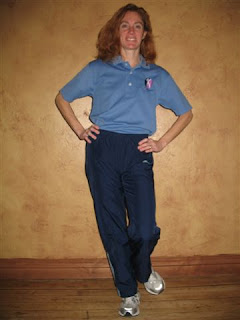 “This!………………………………………………………….. Not This!!!”
2) So, you can stand on one foot, what about the other foot? Can you stand on one foot significantly longer than the other? If so, start working on the weaker side. The more equal your strength from left to right, the less risk you have of injury.
3) If you have good balance, and can stand on each foot for 30 seconds it is time to start challenging your balance by moving non-weight bearing leg. Focus on standing tall, and lift one leg out in front of you with your foot about 12 inches from the ground, then move it out to the side and finally to the back. The first time you try this use your arms for balance, then make it more challenging by crossing your arms over your chest.
4) Strength training on one foot is a great way to trick your body into using your core muscles as stabilizers. Try doing any strength training move that you usually do either sitting or standing on two feet while standing on only one foot and you will definitely feel some extra muscles kick in! For example: bicep curls, lateral shoulder presses, overhead presses.
“This!………………………………………………………….. Not This!!!”
2) So, you can stand on one foot, what about the other foot? Can you stand on one foot significantly longer than the other? If so, start working on the weaker side. The more equal your strength from left to right, the less risk you have of injury.
3) If you have good balance, and can stand on each foot for 30 seconds it is time to start challenging your balance by moving non-weight bearing leg. Focus on standing tall, and lift one leg out in front of you with your foot about 12 inches from the ground, then move it out to the side and finally to the back. The first time you try this use your arms for balance, then make it more challenging by crossing your arms over your chest.
4) Strength training on one foot is a great way to trick your body into using your core muscles as stabilizers. Try doing any strength training move that you usually do either sitting or standing on two feet while standing on only one foot and you will definitely feel some extra muscles kick in! For example: bicep curls, lateral shoulder presses, overhead presses.

23-Jan-2009
Comments Off on >New Group Sessions for February
>New Group Sessions for February
Category : Exercise
>Cycle & Go / Cardio & Go
We coach you through the workout to ensure these short trainings are intense and effective! These sessions are wrapped up with 5 minutes of stretching and flexibility.
Stay for Strength
30 minutes of muscle conditioning exercises utilizing a variety of muscle conditioning tools to tone and sculpt your entire body and enhance your overall fitness. Follows Cardio & Go or Cycle & Go, so you can attend them back to back for a complete workout!
Stay for Core
30 minutes of core conditioning. Train your stabilizer muscles around the abdominal and spinal regions. Utilizing the very best mat Pilates moves, and incorporating stability and medicine balls, these sessions will help develop strong mid-section, improve your posture, and reduce the risk of low back injury. Follows Cardio & Go or Cycle & Go, so you can attend them back to back for a complete workout!
Mind/Body Stretch
Improve your flexibility, muscle endurance, and balance through a wide array of Yoga and Pilates moves. We have selected only the safest yoga and Pilates moves for the general population. Stretching and breathing are emphasized to enhance relaxation and stress release.
Strength & Agility
Dynamic muscle conditioning for the whole body combined with drills to improve agility. As it sounds, this intermediate to advanced training is for individuals with a solid base of fitness who are looking for a challenge. Expect a gradual warm-up into some more intense moves followed by a cool-down and stretch to start your day with exuberance (5:45 am)!






